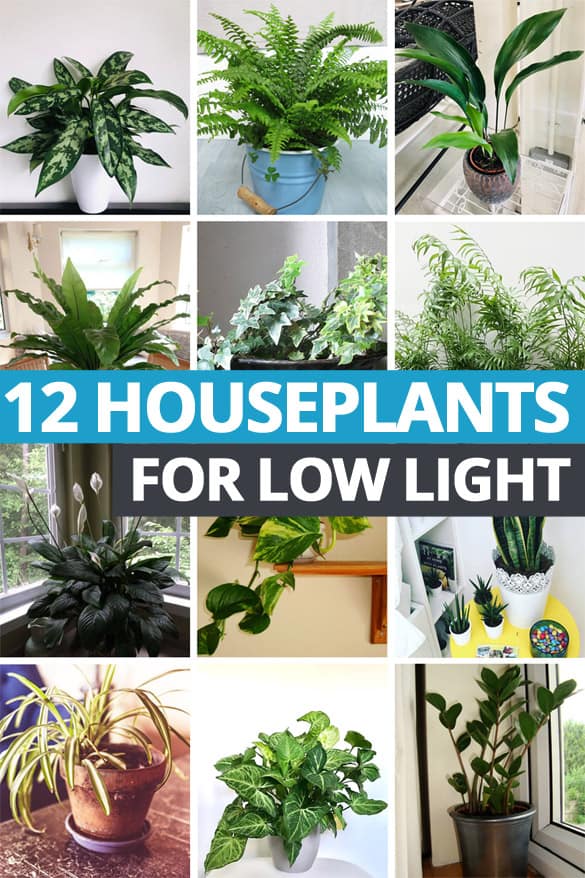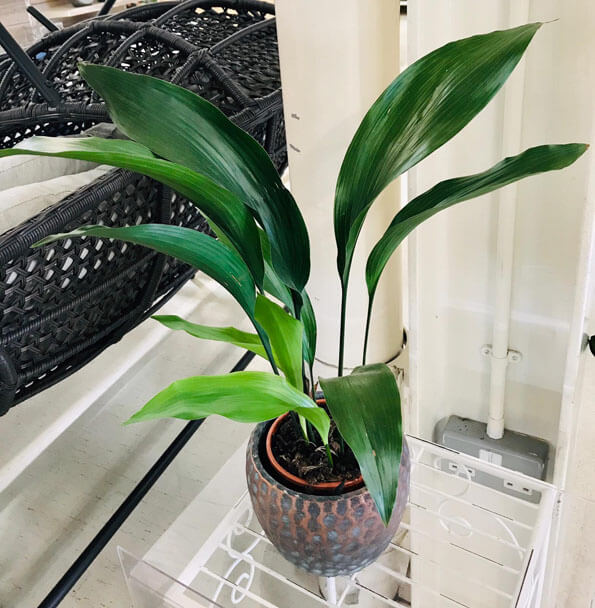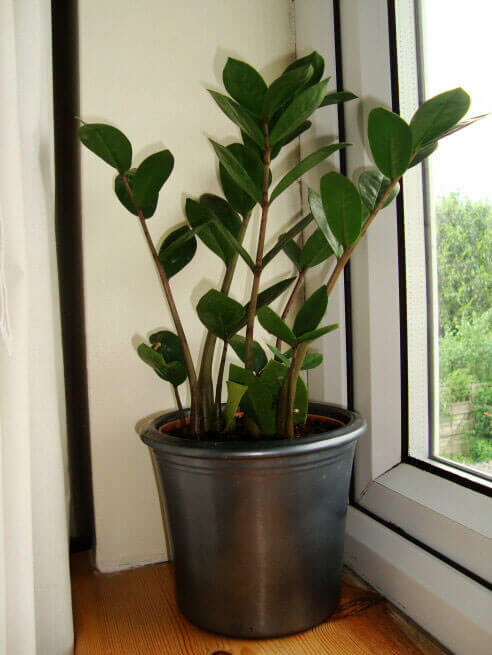We all have dark and shady spots in our homes, with no direct sunlight or natural light sources to brighten up the area. These are classic low light locations.
You might think these spaces are no go areas for plants but actually, that's not totally true. A good number of plants will survive and still do reasonably well in these places.
If given the choice, few houseplants, if any, want to be grown in those low light spots but there is a select few out there that will never complain about it. They'll keep quiet, behave and do their best, continue to look beautiful and light up that dull spot like a beacon.

Many houseplants are suitable for low light spots in your home, including these 12
There are some important things to take into account when growing plants in low light, so check them out now, or carry on reading after you've finished up with the list.
In the meantime here's 12 easy plants we personally grow in low light conditions and have done so for several years without any problems or major issues.

Hi, I'm Tom!
If you're like me and enjoy the challenge of growing houseplants and getting them to thrive, then Ourhouseplants can help. This website shares my knowledge and years of growing plants and provides (hopefully) helpful advice on properly caring for your indoor plant friends.
1
Chinese Evergreens or Aglaonema are the traditional low light houseplant. The ones with decorative stripes look like tropical plants and keep their colour well, even in deep shade. Unlike many plants that are just tolerant of low light, some of the Aglaonema varieties will not just survive but actually, thrive and produce a few new leaves each year.

Many Aglaonema varieties will thrive and bring a bit of joy to a dreary corner.
Ideally, these plants would opt for Medium Light levels to perform at their best, but can go as low as just one step away from almost total darkness. No matter the light level, they remain low maintenance and are a popular houseplant for most homes.
2
Possibly the most famous hardy houseplant of all time. The Aspidistra with its large green leaves will cope with it all, wild temperature changes, dusty leaves, cold draughts and even fumes from coal fires (those Victorians expected a lot from these plants!). So it's probably no surprise that low light growing doesn't even faze this houseplant.
Capable of dealing with poor light, the Cast Iron Plant also handles poor air quality and variable temperatures
Despite all this plant cruelty, they handle it all and somehow still look perfectly elegant and pulled together. Its only weakness is sunlight and frequent repotting, both of which can finish it off quite quickly.
3
Asplenium nidus or the Bird Nest Fern, if using it's common name, is really understated and frequently overlooked for their more vibrant cousins.
With their wavy, permanently glossy leaves (which don't shed everywhere, yes Boston Fern, we're looking at you) they add some serious grace and style to all corners of your home.
Adaptable to a variety of light conditions, low light is no exception where they'll cope with it like troopers and don't make any fuss about it.
As well as low light they also don't mind being grown in small pots.
4
It might drop it's leaves regularly but the Boston Fern (Nephrolepis) doesn't do this because of being put in a dimly lit location. Like all the plants listed here, it's perfectly happy growing in places like this. The leaf loss is actually caused by our bad watering routine! Tip - They like moist soil!
Grow the Boston Fern if you appreciate it's graceful, drooping fronds and tranquil calming effect. It looks good and puts up with a lot. One of our favorites.
Boston Fern in a blue bucket by bfishadow
Although adaptable to low light, it should ideally be grown in a medium-low light (or brighter), rather than low-low light.
The leaf loss, hinted at above, can be quite common and if the light levels are low then new growth to replace what's been lost will be slow or non-existent. You need a brighter spot in order for new leaves to grow. Trust us when we say there is nothing more sorry looking than a bald Boston Fern!
5
Have you got cool locations, check. Dingy spot, check. Nice pot, check. English Ivy could well be the perfect match for you. It can put up with loads and still happily slither and clamber over pretty much anything. In many ways, it's the ideal indoor climber.
It might not be the best plant for you if you like your home on the very warm side or you live in a modern building. They prefer cool rather than warm locations and warmth will just encourage their arch-enemy the Spider Mite to set up home and completely strip your plant.
It's also easy for them to be overwatered so take care with how much you give and ensure your Ivy is growing in well drained soil.
The English Ivy prefers semi-bright locations, but will put up with dim light - photo by Cristina Sanvito
6
Most Palms need quite a bit of light to do well in our homes. The Parlour (or Parlor) Palm bucks this trend and can put up with some fairly dim places. This is a strong room enhancing plant and should be a serious contender if you want a palm but can't provide the usual bright light they normally need.
The Parlour Palm - beautiful, attractive and delicate looking. Don't be fooled though this houseplant will put up with a lot
My Palm grows on a shelf near the ceiling in a North Facing Room. It's one of the darkest places in the entire house but it never makes any kind of fuss and will even produce a few new fronds each year with the green foliage giving a textured look.
Just remember that it's a slow grower even in light shade. But it'll grow faster and you'll allow the aesthetic shape, colour, and form of these plants to properly shine if you move it to a place with better light levels.
7
Of all the houseplants in this article, the Peace Lily is hands down the most well known "low light" indoor plant. The reputation is well deserved, they'll literally put up with almost total darkness and should be your go-to plant if you want something that's easy to care for and will live just one step away from total darkness.
Peace Lily - Potentially the most famous houseplant in the world to grow in low light conditions. Photo By Judy A.
The Peace Lily in the photo above is enjoying bright indirect light, but two of mine are being grown in the lowest low light locations I have. One in a small bathroom with no windows, where the only light comes from a window in a nearby bedroom. The other grows on top of a cupboard in a windowless landing.
Although both plants have done well in these spots, they've not produced any new leaves (or at least any that I can remember).
Both are perfectly fulfilling the definition of a surviving rather than thriving plant. Yes, you don't need to tell me, I already know I'm a very bad person. My excuse is that I want some greenery in these spots and they're literally the only ones that will take such low light levels.
8
The popular Pothos is again very similar to the Aglaonema in that low light places will mean any variegated types will retain their attractive markings fairly well and not fade or change colour to a great extent.
They also accept cooler temperatures so will make great trailing houseplants for less hospitable areas in your home but where you still want a bit of nature to brighten things up, such as hallways.
Poor lighting isn't a problem for Pothos
Until you're used to your Pothos quirks and needs, be extra careful with the watering. Too much or too little over a long period can cause yellowing of the leaves which will eventually fall off, making the trailing vines look bare which isn't an attractive look for these plants.
9
Our Grans loved Sansevieria plants and everyone seemed to have one. Then they fell out of fashion quicker than Flares, Uggs and clothes with elbow patches. But now they're back with a vengeance and one of the most trendy indoor plants once more. #SansevieriaSunday anyone? (Tag us if you do - @our_houseplants)
Whether you have (or want) just one or maybe six, they make superb adaptable houseplants, whether you have sunny windowsill or a dark corner they'll take what they can get and still be totally happy about it.
All you have to watch out for is the watering. The golden rule around this, states: less is more. Too much water combined with low light is not a good mix. Trust us. Don't do it unless you want a soggy rotten mess on your conscience.
Snake Plants with their fleshy leaves, look striking anywhere in the home, including those darker corners
10
The happy go lucky Spider Plant is a real cutie of a houseplant. Perfect for beginners and all the varieties on offer today mean they're still attractive enough to appeal to old hands. They'll deal with a lot, including poor illumination, nor do they grow to a very large size, making them perfect spot plants.
Spider Plants are perfect for the beginner, almost nothing phases them.
When the parent is being grown in poor lighting, Spider-Babies are much less numerous and less commonly seen. So if you want some Spider-Babies, give the parent plant a long holiday vacation for a few months somewhere they can bathe in bright (but not direct) sunlight.
11
In good indirect light, Syngonium, otherwise known as an Aarrowhead plant can grow and trail very quickly and very easily. Unless you're training the vines it will get out of control before long and look pretty messy.
These plants arguably look their best when they're compact and everything is tight, with the little twists and waves of the leaf edges they have an amazing "pop" about them.
A benefit of growing it in low light conditions will be the slow and stunted growth which almost freezes the plant in time. Ours (photo of it below which was moved temporarily somewhere brighter for the photo!) has been grown constantly in low light for about a year or so now and it's hardly changed since the day it was brought home.
The Goose Foot Plant in all it's glory, even a gloomy spot won't spoil it
12
The ZZ Plant or Zamioculcas zamiifolia is rapidly becoming the interior designers go-to plant. They have a modern look about them, are robust and easy-going with a high tolerance of different light intensities, including low light.
Growth is normally sporadic at the best of times, with everything being quiet for months before a huge new shoot (or two) will rapidly burst into life over a matter of weeks. In low light conditions, growth is much less or even non-existent. Conditions like these aren't good for plants you want to grow and fill out a little bit, but otherwise, you can tuck it away in a dimly lit corner and it'll do you proud.
The ZZ Plant and it's glossy green leaves - don't worry, low light won't dull this beauty
13+
What's that you say? You want MORE low light capable houseplants? Well, we're a bit tired at this point not to mention that 13 is an unlucky number for some. So how about letting Amanda from Planterina go through her low light list. It's 37 plants long that covers a wide range so it's sure to give you even more inspiration.
Check out Amanda's tried and tested "best low light plants list" by clicking the picture above (it's epic)
Here are some pointers to think about when trying to balance your plants' care needs against these sometimes challenging environmental growing conditions.
You may be wondering what classifies as a "low light", or even how it's different to "bright light" or "medium light". In general these are broad terms. Sometimes people will measure light levels, but for the average plant owner, this isn't realistic.
A more comprehensive explanation on the topic can be found in our Light Guide. For a brief overview instead, check out the drawing below.
Drawing by LÉON & GEORGE showing examples of the different light levels you can find in a home
(Click the picture for a bigger version)
So how were our suggestions?
Do you have many of them in your own homes already? Or maybe you could recommend a low light plant (we're happy to add more to our list!) Let us know in the comments below.










